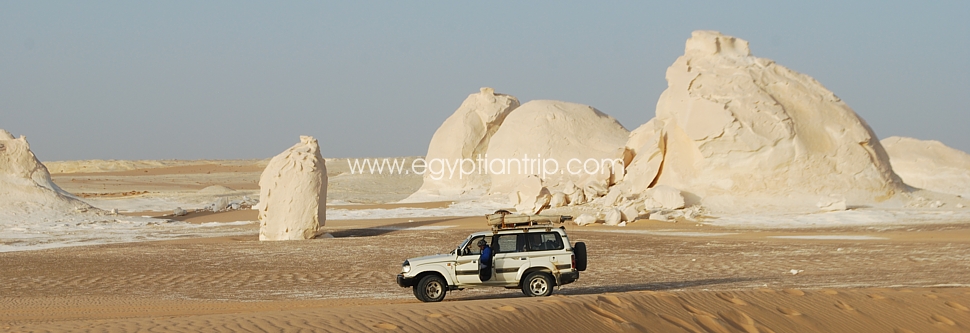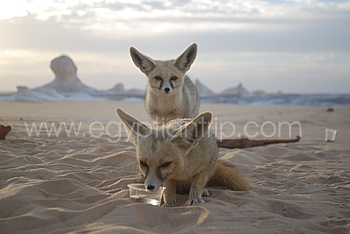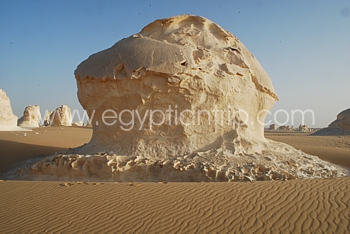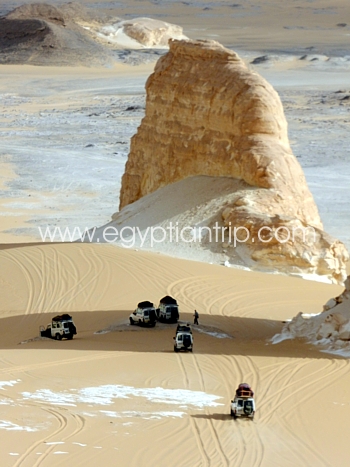
|
| The white desert is the most popular and interesting area in the Western Desert. The white desert became a protected area since 2002. It occupies a surface area of around three thousand kilometers. On the road that goes between Farafra and Baharya, one can see the first bizarre rock formation in the white desert. Some rocks look like animals, mushrooms, and some rocks have totally strange shapes. Farafra is nearer than Bahariya to this 300 kilometres protectorate, yet it offers a more limited choice of tours and safaris. However, it is still the perfect starting point for an overnight journey into the infinite whiteness. The famous and dramatic gleaming chalk landscape of the Farafra Depression is one of the most astounding natural wonders of Egypt. The strange rock formations that rise above the white surface of the desert are known as inselbergs (from the German for 'island mountain'). Here at Farafra, they form a 20km long series of free-standing formations in front of the northern escarpment. They are also found on other planets and the ones in the White Desert of Farafra have been studied closely to promote greater understanding of the surface of Mars. Here on Earth they are formed when a plateau begins to break down leaving the harder rock still standing while the softer parts erode. The rock layers were deposited when the desert was underwater and marine fauna which died settled at the bottom of the ocean forming sedimentary rocks. Viewing the sparkling white landscape covered with almost supernatural shapes spectacularly lit at dawn, midday and especially sunset it is hard to believe the humble origins of this dramatic and impressive scenery. The outer parts of the White Desert nearest to the road are known as the Old Desert because these were the areas accessible without 4WD. Almost as soon as you enter the White Desert Park you are surrounded by gleaming white mushroom shapes. Then you reach the tenacious 300 year old acacia tree known as Santa. After leaving Santa you reach the area called White House and then are into the so-called New Desert only easily accessible since the introduction of 4WD. In the near future the New Valley authorities intend to mark roads using stones as markers and will penalise drivers who leave the designated routs. Spending a night in the White Desert is a magical experience. Sitting by a fire smoking a sheesha (water-pipe), getting a lesson on how to navigate by the stars or simply sitting in silence staring in wonder at the clear unpolluted night sky glittering with a multitude of stars is an unforgettable way to spend time. At dawn when the new light hides the stars it also reveals shapes and shadows that will be gone as soon as the sun gets higher. Every time of day reveals a different desert to you. As the saying goes" nature is the art o god". The white desert is clear evidence on this ability of the god to form his universe. Maybe this is why the "finger of god" is located in the white desert. The finger of god or "Al Qubar", the Chisel, is a 20 meters high rock formations that can be seen from far away even from the paved road and the locals like to call it the finger of god as it looks like a huge finger rising from the sand. To the northeast of the white desert, there is an area called Aqabat, or "obstacles" in English. Of course this name had a reason and this area is full of obstructions that face anyone who wants to pass through. In the middle of this area, lies the mountain of Twin peaks which is an important landmark for travelers. In the west section of the white desert, which is much less visited than the East section because of the poor conditions of the roads leading to it, there is the ancient site of Wadi Al Ubayid, or the white valley. |
   |
|